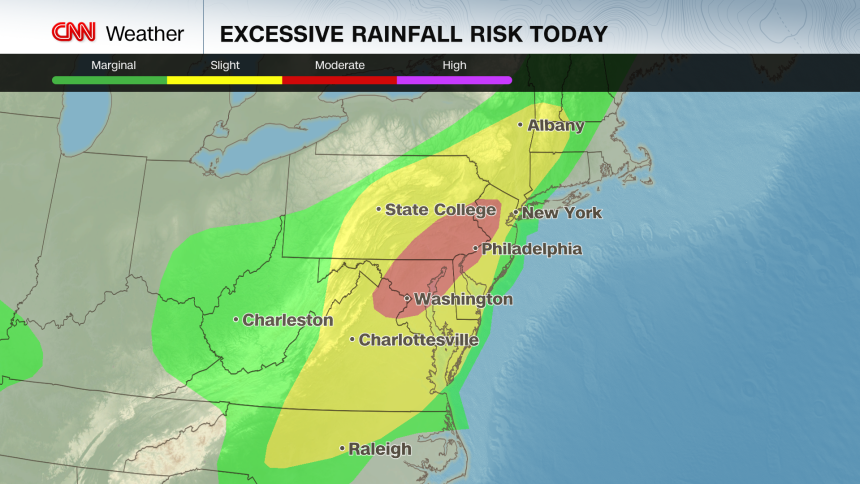Slow-moving summer storms capable of extreme rain are poised to drench the East Coast Monday, threatening millions from North Carolina to New England with even more dangerous flash flooding.
Rainfall totals could reach 2 to 4 inches in Monday afternoon and evening’s storms, with locally higher amounts greater than 5 inches possible. Flood watches are in effect for more than 44 million people across nine states and the Washington, DC, area.
More than 70 million people are in a Level 2 of 4 risk of flooding rain, but a more significant Level 3 out of 4 threat for 20 million people including the Washington, DC, Baltimore and Philadelphia metro areas represents the core of the threat.
It’s still uncertain exactly where the heaviest storms will bubble up, but showers began developing Monday morning and more will dominate the Northeast by the latter half of the day as temperatures rise. The heaviest storms are likely to arrive by early evening and pose a threat to rush hour commuters.
Multiple flash flood warnings have already been issued, including in Greensboro, North Carolina, Newark, New Jersey, and Hartford, Connecticut, as well as parts of central Pennsylvania and Massachusetts. More warnings are likely to come throughout the evening. A few water rescues have also been reported in central Pennsylvania, according to the National Weather Service office in State College.
Storms will continue overnight Monday, but most will move off the coast by Tuesday morning.
Much of the area inside the flood watch has seen up to 300% of their normal rainfall over the past two weeks. Given that, and the staggering rainfall in parts of central New York and Pennsylvania over the weekend, it won’t take much to cause serious flooding in the region.
const fallbackImage = ‘/media/sites/cnn/cnn-fallback-image.jpg’;
img.removeAttribute(‘onerror’);
img.src = fallbackImage;
let element = img.previousElementSibling;
while (element && element.tagName === ‘SOURCE’) {
element.srcset = fallbackImage;
element = element.previousElementSibling;
}
}

Places along the Berkshires in Massachusetts and Binghamton, New York, recorded as much as 4.5 inches of rain over the past 72 hours.
In a typical year, the National Weather Service office in the DC-Baltimore area issues one or two moderate risk rainfall outlooks. This July alone, there have already been three: July 1, 9 and 14. In the past month, there have only been seven days when the DC-Baltimore area wasn’t under any excessive rainfall threat.
Record-breaking flood events have happened nearly back-to-back in recent weeks, most notably in Texas’ Hill Country, where more than 130 people died after catastrophic flooding on July 4. New Mexico, North Carolina and other East Coast states have also seen life-threatening floods and historic rainfall this month.
Overwhelming rainfall is becoming more prevalent in a warming world, as rising global temperatures drive weather toward extremes. Hourly rainfall rates have grown heavier in nearly 90% of large US cities since 1970, according to a recent study from the nonprofit research group Climate Central.
Storms thrive on warm, moist air, and with the nation approaching peak summer heat, this month has seen the perfect conditions for flooding rain. Heat-driven storms can drop torrential rain and tend to move more slowly and stagnate, as upper-level winds in the atmosphere weaken this time of year.
In urban areas, flood risk increases in part due to infrastructure. Many roads, sewers and drainage systems in the US were not designed to handle the kind of extreme rainfall events that are now becoming more common.
Concrete and pavement disrupt the natural absorption of water runoff, which keeps rain from soaking into the ground and instead sends it to storm drains that can easily overflow or become clogged with debris.


